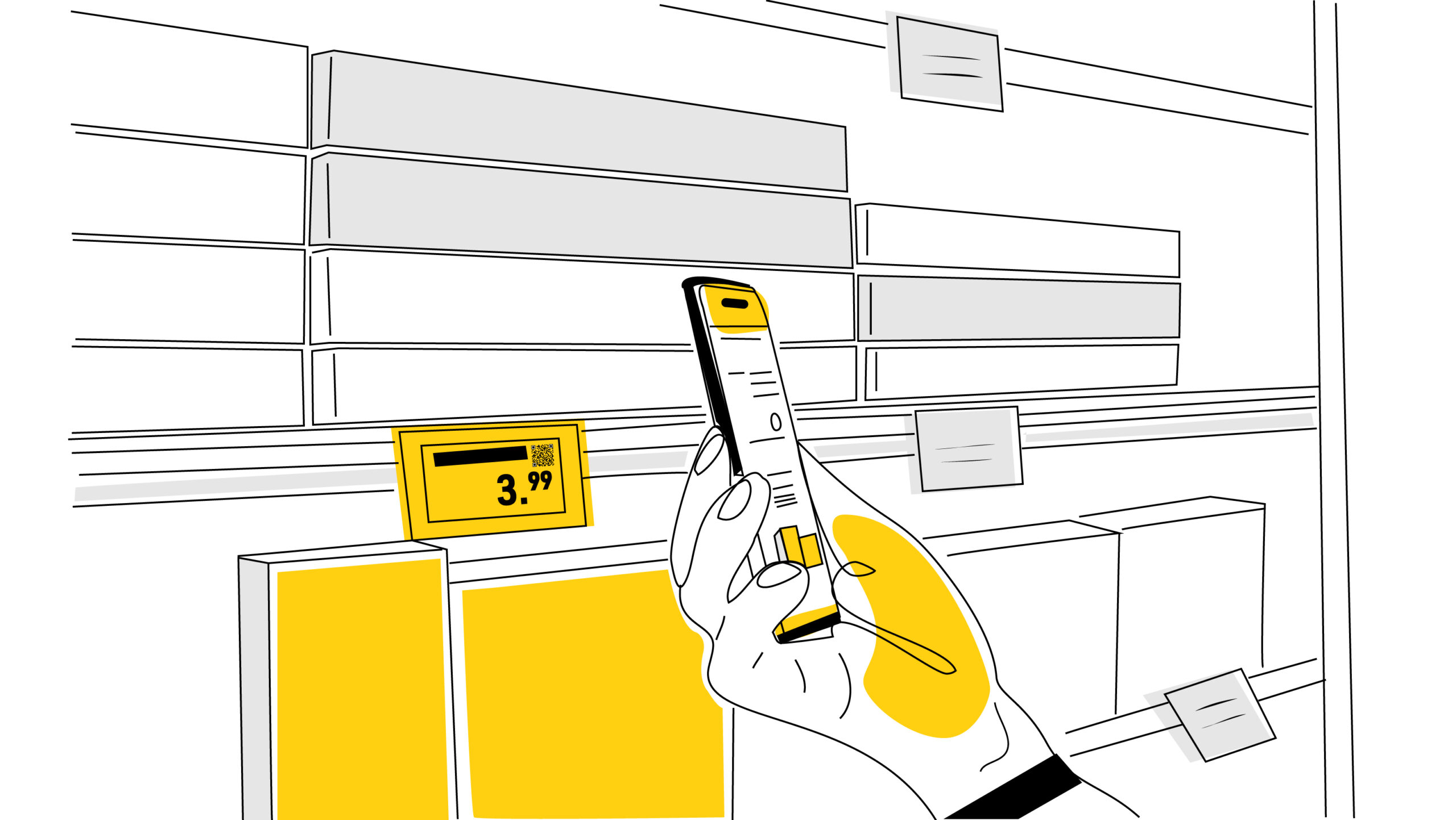7 Reasons Why Retail Media is a Game Changer for Marketers
In this ever-evolving digital era, brands must think outside the box to capture consumer attention. Both the digital retail landscape and offline points of purchase are experiencing profound shifts in how they engage with their target audiences. Retail media is one aspect of these new experiences, allowing advertisers to strategically position ads based on real-time category browsing, relevant search terms, and more person-specific factors. Thanks to this approach and advanced technological solutions such as digital price tags, brands can connect with customers in a whole new way right when it matters the most: at the purchasing decision stage.
What Exactly Is Retail Media?
The term “Retail Media” refers to an advertising approach where retailers deliver advertising services, effectively using their store or e-commerce website as a platform to run highly targeted ads. Thanks to retail advertising, retailers own first-hand data they can leverage at the most optimal time, giving them the ability to not only capitalize on their existing relationships with their customers but to nurture and improve the bond significantly.
Retail media is often favored for the on-site advertising possibilities it offers. These are typically sponsored products within the retailer’s digital ecosystem, such as apps, websites, and emails.
With that being said, off-site advertising is also a worthwhile option for advertisers looking to reach targets on third-party channels, including websites, connected TV platforms, and social media accounts. While more complex, off-site retail media can turn to highly effective methods, including retargeting.
Finally, retail media advertising can take place within a retailer’s physical environment. From audio ads playing over store speakers to on-screen, interactive experiences, the practice adds a new dimension to in-person shopping.
As this approach relies on the same set of principles, whatever form it takes, the benefits of retail media within these different scenarios remain comparable.
Let’s delve into some of the most profitable aspects of the strategy.
1. Unprecedented Access to First-Party Data
What makes retail media so unique is its seamless integration of ad impressions and sales on the same platform, which offers a distinct advantage. The data generated by the consumers as and where they are shopping provides valuable insights, empowering brands to refine their approach over time. Retail media networks make this first-party data easy to access and leverage, opening up opportunities for brands to devise elaborate advertising strategies with highly targeted messages that will reach the ideal audience at the most crucial time.
By placing first-party data at the disposal of retailers, retail media networks give brands better control over their advertising, enabling them to allocate their budgets on a granular level, optimize their strategies, and boost ROI, all while maintaining a competitive edge.
2. Enhanced Customer Journey Insights
What sets retail media apart is the high level of personalization it provides, delivering customized ads for every consumer based on context and behavior. For retailers, being able to analyze individual customer journeys and utilize this understanding to create stronger relationships is pivotal. By collecting data right at the point of sale, retail media solutions offer retailers a future-proof solution to help them nurture the bond with shoppers, connect with them more authentically, and target their ads for maximum impact.
From digital price tags to interactive, sensor-augmented aisle displays, the solutions to collect first-party data about shoppers’ intentions are seamless and engaging, going much further than after-the-fact options such as loyalty cards, which mainly target the next purchase.
3. Increased Brand Visibility at the Point of Purchase
Influencing the shoppers’ purchasing decisions can only happen if the right product suggestion is made when the consumers are at their most receptive. In other words, when they are actively shopping. This is something that big online retailers such as Amazon are able to act on easily, as their retail media strategies apply to fully virtual environments where the users’ attention is already focused on their screens.
This prominent visibility is also within the grasp of retailers with physical stores, thanks to retail IoT technology, which brings digital enhancements to in-person shopping environments. Strategic and well-timed placements can give key products a distinctive presence, allowing retailers to capture the shoppers’ attention and spark their curiosity for products they will find personally relevant.
4. Retail Media Networks: A New Revenue Stream for Retailers
Advertising that integrates retail media networks offers a reliable way to retain shopper marketing dollars. With this method, investing in end caps, on-shelf advertising, and other types of in-store marketing can finally make sense again, after the rise of on-demand and delivery services had strongly impacted the relevance of such strategies. By delivering accurate and targeted marketing to shoppers, thanks to expertly leveraged first-party data, brands and retailers can position themselves right where consumers tend to spend their money.
The idea is to capitalize on the profitability of digital approaches and establish new and high-margin revenue streams, capturing consumers in their “peak shopping mindset”. Retail media allows retailers to reach consumers in a digital context through placements on their O&O (Owned & Operated), driving interest and traffic with no go-between. They can “push” the right brand or product at the most opitmal time, thus maximizing its potential.
Retail media networks revolutionize the market, placing them at the top of retail trends. They provide a way to find and connect with new customers who may not have been receptive to other forms of communication, offering new touchpoints where the shopper and retailer can “feed off each other”. The shopper benefits from this relationship by receiving highly relevant product suggestions. The retailer collects brand data and customer intelligence that can be used to drive product development and come up with more personalized products and messaging, keeping up with ever-changing consumer needs.
Finally, media monetization constitutes an alternative stream in and of itself, letting brick-and-mortar stores in on the online action. This helps them maintain a competitive edge while embracing innovative revenue strategies where pricing, logistics, and transportation don’t carry their usual weight. In other words, allowing brands to run targeted ads on their channels (digital or physical) generates additional revenue without eating away at the retailers’ margins.
5. Precision Targeting with Advanced Analytics
The success of a retail media strategy hinges on first-party data. But, more importantly, interpreting this data to derive purchasing patterns across customer journeys is what powers the personalization of the experience and the ad targeting that condition the effectiveness of retail media campaigns.
This requires advanced analytics and reporting tools through which all the data collected can be consolidated, providing retailers with actionable insights. The Vusion Engage marketing platform allows retailers and brands to partner on impactful in-store digital campaigns based on real-time information. Thanks to our end-to-end solution, they can achieve higher returns on ad spend by automating every aspect of their actions, measuring and benchmarking their campaign performance as they go.
VusionGroup’s Engage centralizes retail media campaigns and maximizes the sale of in-store inventory by matching audiences to the most relevant products, both in terms of their interest and in terms of the retailer’s offerings.
The connection between data sources is one of the most crucial aspects of media retail. From data management to centralized analytics and data-sharing partnerships, how we address and solve divided data is just as important as the technology used to collect it.
6. The Synergy Between E-commerce and Retail Media
Digital retail media is transforming the relationship between marketers and consumers. In today’s world, the gap between in-person shopping and online experiences is quickly being bridged, and modern shoppers are enjoying more fluid journeys. What used to constitute multiple touchpoints is now merging into precisely targeted interactions that foster deeper connections. Through retail media networks, consumers explore their interests, discover new products and trends, and are placed at the heart of a cohesive, elevated story that transports them seamlessly between the store and its custom-built digital environment.
This holistic approach incentivizes consumers to connect. From improved personalization to high-value offers and features that tie in both with loyalty programs and their immediate purchasing path, shoppers finally enjoy complete coherence between the convenience of online purchases and the engaging aspects of in-person environments.
7. Navigating Challenges and Embracing Opportunities in Retail Media
As third-party cookies are reaching their expiration date, brands must look elsewhere for reliable, future-proof data to leverage in their marketing strategies. Retail media provides comprehensive and insightful data and contextualizes it in a space with ever-expanding areas of growth: the digital world.
Of course, building effective retail media networks also requires some careful consideration. Resources are a particularly crucial aspect of any retail media strategy. From the ad budget to the reach of multichannel campaigns and the brands featured, multiple factors come into play.
For most retailers, product niches also warrant selecting one platform over another. For example, electronics or groceries could benefit from an Amazon partnership, whereas stores with more specialized wares may wish to turn to partners within similar sectors. Choosing relevant services – such as international advertising – also impacts budget requirements and the methods selected.
Finally, aggregating analytics can become a concern when several retail media networks coexist within the same campaign. Yet, having access to in-depth, accurate reporting is essential to understanding performance and refining strategies. This is why having the right retail media technology can make all the difference. From real-time result tracking to automatic high-intent audience identification, campaign measurement, and retail data activation, all these sensitive aspects of running successful retail media operations can be handled reliably and securely through a dedicated solution.
Key Takeaways: The Strategic Importance of Adopting Retail Media in Your Marketing Mix
Retail media is not intended to be the ultimate substitution for all other forms of on-site and off-site marketing. With that being said, it inscribes itself in a future-driven approach to marketing and boasts multiple benefits, including:
- Capturing the consumers’ attention where and when they shop. Retail media ad placements on a retailer’s O&O (Owned & Operated) allow brands to reach highly targeted buyers in a digital context. With retail media strategies, shoppers are exposed to ads in the context of shopping, when they are in the ideal mindset. This creates opportunities to find and connect with customers by providing additional touchpoints and boosting conversion.
- Retaining shopper marketing dollars. Retail media is breathing new life into marketing strategies that could have been eclipsed by digital approaches. In-store marketing, for instance, is benefiting from the adjunction of digital channels. Meanwhile, retailers can position themselves right where shoppers direct their attention.
- Leveraging the full potential of first-party data. This crucial information can then be used to offer enhanced shopping experiences through highly targeted ads with real added value for the customer, in turn increasing the likelihood that their journey will lead to an extra purchase.
- Boosting product visibility and conversion (online and IRL). Ultimately, an irrelevant ad is, at best, as good as an invisible one. At worst, it can negatively impact the retailers’ credibility and their shoppers’ loyalty. When ads are served within the ideal context and targeted based on interest, on the other hand, customers delight in discovering new products and offers.


